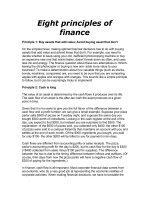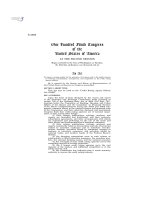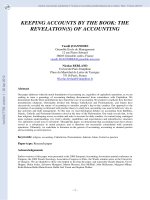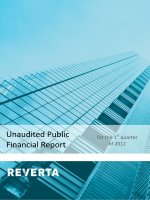The Real World of finance pdf
Bạn đang xem bản rút gọn của tài liệu. Xem và tải ngay bản đầy đủ của tài liệu tại đây (1.27 MB, 224 trang )
The Real World of
finance
TEAMFLY
Team-Fly
®
finance
12 Lessons for the
21st Century
JAMES SAGNER
John Wiley & Sons
This book is printed on acid-free paper.
Copyright © 2002 by John Wiley and Sons, Inc. All rights reserved.
Published simultaneously in Canada.
No part of this publication may be reproduced, stored in a retrieval system or
transmitted in any form or by any means, electronic, mechanical, photocopying,
recording, scanning or otherwise, except as permitted under Sections 107 or 108 of
the 1976 United States Copyright Act, without either the prior written permission
of the Publisher, or authorization through payment of the appropriate per-copy fee
to the Copyright Clearance Center, 222 Rosewood Drive, Danvers, MA 01923, (978)
750-8400, fax (978) 750-4744. Requests to the Publisher for permission should be
addressed to the Permissions Department, John Wiley & Sons, Inc., 605 Third
Avenue, New York, NY 10158-0012, (212) 850-6011, fax (212) 850-6008,
E-Mail:
This publication is designed to provide accurate and authoritative information in
regard to the subject matter covered. It is sold with the understanding that the
publisher is not engaged in rendering legal, accounting, or other professional
services. If legal advice or other expert assistance is required, the services of a
competent professional person should be sought.
Wiley also publishes its books in a variety of electronic formats. Some content that
appears in print may not be available in electronic books. For more information
about Wiley products visit our Web site at www.wiley.com.
ISBN: 0-471-20997-X
Printed in the United States of America
10 9 8 7 6 5 4 3 2 1
For Stephen, Amy, and Robert-Paul
vii
Acknowledgments ix
Introduction 1
PART 1
Managing Financial Activities 15
Lesson 1 Profitability 17
Lesson 2 Working Capital 33
Lesson 3 Financial Responsibilities Outside of Finance 47
Lesson 4 Outsourcing 63
PART 2
Financing the Corporation 79
Lesson 5 Access to Credit 81
Lesson 6 Noncredit Banking Services 99
Lesson 7 Strategic Planning and Capital Budgeting 114
Lesson 8 Rating Agencies 127
Lesson 9 Investment Banking 141
PART 3
Facing Twenty-first Century Challenges 157
Lesson 10 Audit and Control 159
Lesson 11 Risk Management 176
Appendix 11A Guide to the Preparation of Policies
and Procedures 187
Lesson 12 The Chief Financial Officer’s Focus 192
Afterword 206
Index 209
contents
ix
T
his book developed from my teaching and consulting expe-
riences going back three decades. Working with Fortune 500
clients, I have been constantly amazed that finance is almost an
afterthought in the everyday world of business—except, of
course, for such financial services companies as banks and se-
curities firms.
Business today focuses on three priorities:
■ Sell product.
■ Install and maintain information systems to tell
management where it is and where it may be going.
■ Make profits.
Finance is expected to provide permanent capital for in-
vestments and to manage working capital to meet ongoing
requirements. But it is not supposed to get involved in the man-
agement of the business. If you don’t believe this, visit the fi-
nancial function of a company and ask if any senior manager
has ever gone on a sales call, toured the manufacturing floor,
or talked to an unhappy customer.
When I teach finance courses, I often explain that although
the book says “X,” the real world operates in a “Y” mode. Stu-
dents without significant work experience don’t understand
this. Those who are in corporate positions, usually part-time
MBA students, immediately agree. And the question always is:
Why doesn’t someone write a book based on reality?
My gratitude goes to all of the students and managers I have
encountered over the years. They have educated me to a far
greater extent than I have ever taught or advised them. I specif-
ically acknowledge the following:
acknowledgments
x ACKNOWLEDGMENTS
■
My first finance course at Washington & Lee University,
taught by Professor Leland McCloud, using the text The
Financial Policy of Corporations, 5th ed., by Arthur S.
Dewing (New York: Ronald Press Co., 1953).
■ Rosemary Loffredo, assistant treasurer of International
Paper, who was my copresenter of an early version of this
topic at the annual Association of Financial Professionals
in Chicago on October 15, 2001.
■ Timothy Burgard, my Wiley editor, who shepherded this
book through to publication.
Grateful acknowledgment is extended for the permission
granted by the following publications for the use of lesson 12
material that originally appeared in somewhat different formats.
■ To the Association of Financial Professionals for “Roles of
the CFO in the 21st Century,” AFP Exchange,
September/October 2001, Volume 21, Number 5. ©2001,
pages 70–78; all rights reserved.
■ To Financial Executives International for “Today’s Treasury
Function,” Financial Executive, January/February 2002,
Volume 18, Number 1. ©2002, pages 55–56; all rights
reserved.
For any and all errors, I am entirely responsible.
Introduction 1
introduction
He who can, does. He who cannot, teaches.
—George Bernard Shaw,
Man and Superman
What did they teach in your MBA or undergraduate finance
courses? More important, was any of it based on real-life expe-
rience, or did a Ph.D. draw charts and write arcane formulae on
the blackboard? And can you still remember what NPV, IRR,
ECR, LIBOR, bp, Reg Q, and ACH mean? And should you care?
NEW ECONOMY CHIEF FINANCIAL OFFICER
Financial managers in the next decade will face complexities in
several areas not even discussed in the classroom. Examples of
these changing issues include company profitability, audit and
control, the external focus of the chief financial officer (CFO),
financial responsibilities outside of the finance organization,
commercial and investment banker relationships, and the role
of the rating agencies. This book discusses these challenges in
the context of the twenty-first century “new” economy from the
perspectives of the working CFO rather than the textbook CFO.
Why the new economy? And what’s wrong with the old
economy? The old economy has been driven by industrial pro-
duction, resulting in systems of manufacturing and mass mar-
keting. The CFO’s job in the old economy was relatively
simple, because of certain consistencies in the way business
has been conducted:
■ A continuation of similar sales and expense factors. Even
in periods of significant inflation, we assume that we can
forecast and control our income statement results and can
1
TEAMFLY
Team-Fly
®
2 THE REAL WORLD OF FINANCE
construct a balance sheet that supports our business
requirements.
■ Insignificance of the time value of money. We assume
away short-term interest costs and do not adjust for long
production cycles and delayed payment terms.
■ Consistent patterns of customer and vendor relationships.
We have done business with Joe or Jane for 15 years, and
the results are predictable and reliable. Sure, there was a
quality problem eight years ago, and three years ago
delivery schedules were missed by several weeks. But
these vendors are our friends.
The new economy—focusing on finance, information, and
people—is destroying these constants and forcing CFOs and
other senior managers to completely reexamine the way they
do business.
1
E-commerce is globalizing commerce, and you
will be buying from or selling to companies in all parts of the
globe. Business is changing—and the CFO had better adjust to
this new world.
FINANCIAL FABLES AND MISINFORMATION
Here are a dozen lessons taught to every finance student:
1. Profits and returns on equity (ROEs) are the number-one
goal of business.
2. Working capital is a store of value and should be managed
to attain a high current asset–to–current liability relationship.
3. Finance is a specialized staff responsibility.
4. Companies should “own” critical finance functions.
5. Capital markets allocate funds to creditworthy businesses
at reasonable cost for purposes of funding operating ac-
tivities and strategic investments.
6. Banks offer a range of noncredit services to corporate bor-
rowers at reasonable prices as a marketing component to
their lending activities.
7. Capital budgeting procedures support strategic planning.
8. Rating agencies provide objective evaluations to lenders,
creditors, and investors of the financial position of the cor-
poration under review.
9. Investment bankers provide professional advice to com-
panies on the structure of their balance sheets, how to
raise debt and equity, and similar matters.
10. Auditors provide control and prevent fraud.
11. Risk management involves individual functions of insur-
ance, financial engineering, and safety programs.
12. CFOs minimize capital costs and maximize returns.
Not one of these axioms is true although they all certainly
sound logical. This book discusses the mythology of each of
these financial “truths” and reviews current practices based on
consulting experiences with close to 50 percent of the compa-
nies in the Fortune 500.
WHY GETTING IT RIGHT MATTERS
Why does it matter if these financial truths aren’t completely
valid? After all, the disciplines of business and economics are
far from exact sciences. We’re never quite certain if the Federal
Reserve’s action in lowering or raising interest rates will affect
economic activity in the way that’s expected, or if a new mar-
keting or advertising program will sell the latest model car,
toothpaste, or beer.
The reason it matters is that we structure our business lives
to meet the expectations of debtholders, investors, analysts, and
boards of directors with regard to certain truths. If they are not
valid, then the most basic processes of finance—earnings re-
ports, capital strategies, rating agencies and investment bankers
presentations, risk management programs—are flawed and
quite possibly misleading to us and to others. And misleading
or inappropriate actions lead to wrong assumptions, decisions,
and allocations of scarce (and sometimes irreplaceable) capital
as well as flawed business schemes, markets, products, and
technologies.
Introduction 3
The use of invalid financial concepts is a significant prob-
lem in the current environment of evolving business complex-
ity. Finance is experiencing rapid change through the
development of sophisticated management tools that repack-
age traditional instruments or risks into their component ele-
ments. This repackaging allows the transfer or sale of each
portion of the risk or instrument to investors, increasing over-
all economic efficiency.
For example, many risks can now be managed through
hedging or the use of derivatives. Mortgages are packaged
into collateralized mortgage obligations (CMOs) and sold as
Ginnie Maes, Fannie Maes, and other investment instruments.
We clearly do not want a sophisticated discipline potentially
involving billions of dollars to be founded on a flawed set of
principles.
DO BAD FINANCIAL DECISIONS OCCUR?
Financial misinformation, myths, and myopia interfere with the
development of effective decision making and the optimal al-
location of capital. We depend on a body of knowledge to al-
low us to conduct our business activities. Yet half-truths
pervade business practice, often causing significant damage to
companies and entire industries.
Do bad decisions occur? A listing of flawed business de-
cisions would fill a library.
2
The next section reviews the
Sunbeam situation, the dot.com bubble, the telecommunica-
tions industry, and the Enron debacle.
Sunbeam Corporation
In the fall of 1996, the new chairman of Sunbeam Corporation,
Al Dunlap, announced that he would eliminate 6,000 jobs (half
of the company’s workforce), close 16 of 26 factories, sell off
divisions making products inconsistent with the core product
line, and annually launch 30 new products and save $225 mil-
4 THE REAL WORLD OF FINANCE
lion. Dunlap had formerly led Scott Paper (now part of Kim-
berly Clark), where he eliminated about one-third of that com-
pany’s workforce.
Sunbeam’s Plans. The plan at Sunbeam was to build up the in-
ternational small appliance business based on the Sunbeam and
Oster brand names. Some analysts were enthusiastic about the
plan; others were skeptical because of the impact of the staff
cuts on product introductions and other strategic initiatives.
Sunbeam’s balance sheet listed $200 million in debt.
To raise cash in the fall of 1997, Sunbeam sold $60 million
in accounts receivable and initiated an early-buy program for
gas grills, allowing retailers to “purchase” grills in November
and December of 1997 but not pay until mid-1998. Once the
retailers were loaded up with grills, Sunbeam started a second
sales program. A bill-and-hold plan permitted customers to
buy and store their unpaid merchandise in Sunbeam’s facili-
ties. The two sales arrangements accounted for a major por-
tion of the revenue gains in 1997 but were in fact future sales
booked now.
On April 3, 1998, Sunbeam shocked the stock market when
it announced that it would post a first-quarter 1998 loss on
lower sales. After one-time charges of $0.43 per share, the loss
per share was $0.52 in the first quarter of 1998 compared with
earnings per share of $0.08 in the same 1997 period. Domestic
sales, representing 74 percent of total revenues in the quarter,
declined 15.4 percent from the 1997 quarter due to lower price
realization and unit volume declines.
Sunbeam Results. As the result of Sunbeam’s alleged misleading
actions, a series of class-action lawsuits were filed on behalf of
all persons who purchased the common stock of Sunbeam Cor-
poration in the 1997–1998 period. The complaints charged Sun-
beam with issuing a series of materially false and misleading
statements regarding sales and earnings during that period. The
alleged misstatements and omissions were made in an effort to
Introduction 5
convince the investing public of Sunbeam’s continuing double-
digit quarterly sales and earnings growth.
By 1998, the balance sheet showed $2 billion in debt, a neg-
ative cash flow, and a net worth of a negative $600 million. In
June, Sunbeam Corp.’s board of directors terminated Dunlap,
citing poor financial results, marking the end of his two-year
stint at the company. The scorecard was 12,000 employees
eliminated, huge losses, and a demoralized company. “We lost
confidence in [Dunlap’s] ability to move the company forward,”
said one of the directors.
The focus on short-term earnings rather than thoughtful
longer-term strategies forced extreme cost cutting, demoralized
employees, angry retailers, and manipulated sales results to
meet market expectations. Eventually, legal action was taken by
stockholders, and in 2001, the Securities and Exchange Com-
mission (SEC) sued Dunlap and four other former senior man-
agers, charging fraud.
Internet Debacle
Many investors and lenders wonder what they were thinking—
and what the CFOs who supposedly should have known bet-
ter were thinking—in buying, hyping, and managing Internet
stocks on the basis of new economy business models. Instead
of ROEs and cash, we heard concepts like “eyeballs” and “hit
metrics” that supposedly measured customer interest. How-
ever, logging on to a website does not book any sales or pay
any bills.
The problem with many dot.com companies was that they
had no viable business model that had been field-tested in ac-
tual market conditions. In fact, numerous strategies actually
were contradictory to long-established business practices. We
note three of these in the next sections.
3
Illogical Plans. Supermarkets have existed for decades on mar-
gins less than 2 percent of sales. Profits depend on bulk pur-
chasing, low labor costs (except for such specialized workers
6 THE REAL WORLD OF FINANCE
as butchers and bakers), low site costs, and consumer partici-
pation in the buying activity. When online groceries promised
competitive pricing and free delivery, they failed to appreciate
the cost incurred in order picking and delivery now imposed
on and accepted by the shopper. Consequently, most of these
online companies (i.e., Webvan) failed.
4
Vague Plans. Several dot.coms have had vague business plans,
spending tens of millions of dollars trying to find a viable
strategy. Often the original orientation was to develop a web-
site that would be visited by a growing number of potential
customers, who would develop a habit of returning to the site
for guidance or ideas on such specific interests as women’s is-
sues, health questions, or investment advice. The dot.coms
would make most of their revenue from advertising on the
site, and some would generate fees from related ancillary serv-
ices. Unfortunately, most of these companies never attracted
enough “eyeballs” or advertisers and have not survived (i.e.,
drkoop.com).
Naive Plans. All businesses (except those with protected mo-
nopolies) must constantly monitor what the competition may
be planning, particularly in response to initiatives that
threaten their survival. Rival companies may not care if you
introduce a new color or a new shape to your widgets. They
will care if you develop a technology that eliminates the need
for widgets.
The dot.com industry generally paid little attention to the
appearance of companies that directly competed for the same
customers using similar screen appearances, pricing, and
marketing appeals. The ease of Internet browsing makes
competitive shopping an inherent problem, and various stud-
ies show limited customer loyalty to specific sites. Further-
more, established retailers (i.e., Wal-Mart) with nearly
unlimited capital have developed their own e-commerce ac-
tivities to retain loyal customers.
Introduction 7
A Dot.Com Success. There have been a few near successes in
terms of control of a specific market, satisfactory service, and
customer loyalty, with the most notable being Amazon.com.
However, even with nearly 20 million customers, the com-
pany has yet to make a profit, and it reported a loss of $1.4
billion in the most recent 12-month reporting period, the fis-
cal year ending December 2000. Amazon’s accumulated net
worth is a negative $2.3 billion, and with books and other
merchandise offered at a 20 to 40 percent discount from re-
tail, there continues to be doubt that the company can ever
make a fair return. Meanwhile, cash reserves are quickly run-
ning down at many dot.coms, and some four or five dozen
may have less than one year of funds remaining.
5
Telecommunications Industry
Telecommunications was a glamour industry in the last years of
the twentieth century, due to global deregulation,
6
new prod-
ucts and services, and excitement in the financial markets.
However, the industry was actually in some disorder, due to
competing technologies (i.e., wireline or wireless, narrowband
or broadband), many new companies, unrealistic borrowing
commitments and equity investments in capital assets, and cut-
throat price competition.
In just the 1996 to 1999 period, total spending exceeded
$350 billion, with $85 billion in debt and $25 billion in equity
raised to construct communications networks.
7
Stock prices of
telecom service companies and their equipment suppliers
plummeted as investors lost faith in the ability of the established
companies (e.g., AT&T, certain of the Baby Bells) to compete,
while realizing the uncertainty of these high fixed-investment
business plans. Debt exceeds $700 billion in the United States
and Europe, and a significant portion is likely to go into default.
Telecom Results. The CFOs of the various telecom companies
made three mistakes in this potential financial debacle:
8 THE REAL WORLD OF FINANCE
1. Dependence on debt. CFOs permitted telecom companies
to become addicted to debt capital, erroneously believing
that the lower explicit cost of debt justified huge infusions
of bond financing. One example is AT&T, which increased
its long-term liability position from $7 billion in 1998 to $57
billion just two years later.
2. Reliance on investment bankers. CFOs relied on invest-
ment bankers to provide guidance on financing and on
bondholder and shareholder expectations. While the mar-
kets absorbed the securities (at increasingly higher costs),
it is not clear that totally objective and accurate advice was
provided. Investment bankers receive substantial fee in-
come when deals are done; feeding an addiction may not
be good ethics, but it’s good business, at least in the short-
term when the brokers’ bonuses are paid.
3. Absence of viable contingency plans. Capital spending
soared but revenue growth was only moderate during this
period. When returns on equity begin to decline—the in-
dustry’s returns fell from about 14 percent in 1996 to about
6 percent by 2000—the CFO must quickly implement ap-
propriate contingency plans. These may involve reduc-
tions in capital plans, companywide reviews of expenses,
and other actions. AT&T apparently did none of these
things, and instead overpaid for acquisitions and did not
adequately respond when revenue growth projections did
not materialize.
The inevitable result will be consolidation, failure, and re-
organization until the economics of the industry rationalizes.
8
Meanwhile, more nimble competitors, who are unencumbered
by investments in fixed assets, offer such new technology to
customers as fiber optics. Profit opportunities may reside in
computer and Internet activity, and there is the possibility that
data, priority delivery, and other features can produce value-
added service and superior revenues.
Introduction 9
THE ENRON DISASTER
Probably no situation in recent years illustrates more finance
lessons than the Enron Corporation. Much of the story remains
to be revealed in congressional hearings, court proceedings,
and administrative reviews. However, we do know that the fi-
nance function became a key element in their business strategy,
focusing on the trading of energy and such new commodities
as broadband capacity and water services.
Enron created off-balance sheet partnerships to transfer
marginal assets and liabilities resulting from bad global invest-
ment decisions in water and power distribution. These struc-
tures involved increasing complexity and risk, and had triggers
that required the company to assume the partnerships’ debts
that included declines in the price of Enron stock and a down-
grade of the credit rating to below investment grade.
Although the off-balance sheet deals were effectively guar-
anteed by the company, nearly every credit rating agency, an-
alyst, and banker ignored the total potential liability to Enron.
The rise in the common stock price (from $20 a share in late
1996 to $90 a share in mid-2000) lured investors, and these
arrangements became a primary financing driver. However, as
the stock price began to decline in sympathy with general
market conditions, the company became unable to do new or
to contain existing off-balance sheet ventures. By the fourth
quarter of 2001, confusing financial disclosures disturbed in-
vestors and the financial community. The company’s stock
price effectively sunk to zero, creditors lined up to litigate,
and the U.S. Department of Justice began considering crimi-
nal charges.
Ten of the twelve lessons in this book are reflected in the
Enron story. Because of the limitations of the book, we are not
discussing other considerations:
■ The sad stories and lessons for the twenty thousand jobs
and retirement plans put at risk by these actions
10 THE REAL WORLD OF FINANCE
Introduction 11
Lesson Enron Outcome
1 Earnings were manipulated by shifting debt and assets to
off-balance sheet partnerships. In addition, the company’s
accountants may have inaccurately recorded losses
suffered by the company.
2 Management advocated new economy concepts, including
the importance of intellectual capital and the drag of hard
assets. However, cash flow must be carefully managed to
finance current operations. By late 2001, Enron was burning
cash at an estimated rate of $700 million a year.
3 In perhaps no other company in recent history did finance
pervade the entire Enron culture. However, the company was
engaging in trading operations that required a rigid structure
of controls, including continuous marking-to-market of trading
positions,
9
and the ability to quickly liquidate unprofitable
holdings. These requirements were not adequately managed
or understood by Enron’s various businesses, and eventually
contributed to the company’s downfall.
5 Commercial banks ignored the basics of proper financial
management, and continued to pump billions of dollars of
loans into the company. J.P. Morgan Chase admits to $2.6
billion of exposure, and various analysts estimate that Citibank
is owed $2 to $3 billion and Bank of New York some $2 billion.
7 Enron invested in numerous global businesses that
eventually triggered the use of off-balance sheet
partnerships, largely to hide their mediocre performance and
avoid damage to the company. Among the worst of these
investments were Wessex Water (England) and the Dabhol
power plant (India).
■ The impact on the energy industry (Enron handled one-
fifth of the energy transactions in the United States.)
■ The company’s dubious place in business history as the
largest U.S. bankruptcy, involving $62 billion in assets
(nearly double the second largest, Texaco, in 1987).
TEAMFLY
Team-Fly
®
12 THE REAL WORLD OF FINANCE
Lesson Enron Outcome
8 The rating agencies, despite having better access to
company management than the average investor, failed to
downgrade Enron’s credit ratings until late 2001. As of this
writing (early 2002), it was not clear if the raters did not
understand Enron’s complex financial engineering, were
denied access to critical data, or were simply reluctant to
downgrade the company’s ratings.
9 Wall Street analysts and the investment banking community
continued to promote Enron, even issuing “buy”
recommendations as late as November 2001. It is suspected
that the investment banking firms were concerned about
preserving their existing or potential deals with Enron.
10 Internal and external auditors (both Arthur Andersen)
ignored the secrecy, the lack of disclosure, and the complex
structure of Enron’s various financial arrangements.
Andersen now claims that illegal acts may have occurred,
and the SEC and other regulators are investigating.
Andersen’s own behavior in destroying audit papers has
appalled business and political leaders.
11 Senior managers did not understand the cumulative effect
of the company’s various trading instruments and
investments, did not run an effective “matched book” of
assets and liabilities, and were trading commodities in
unregulated and unsupervised markets.
12 The former CFO Andrew Fastow, following the lead of the
former CEO Jeffrey Skilling, created this disaster, rather
than managing capital costs and developing a viable
financial structure. Their apparent goal was to support the
Enron stock price. However, the CFO failed to establish
reasonable controls or to establish an organization that
could effectively monitor the company’s financial activities.
IT’S BACK TO SCHOOL!
Each of these situations illustrates a lesson discussed in this
book.
■ Sunbeam: The mindless focus on profits (lesson 1)
Introduction 13
■ The dot.coms: The failure to construct logical business
plans (lesson 5)
■ The telecom industry: The bias of investment bankers
(lesson 9)
■ And of course Enron: The “poster-boy” for 10 of the 12
lessons
We could cite equally relevant real-life situations for each les-
son using situations from the past few decades. However, the
point is not to throw stones at the guilty—that could fill a shelf
of books! Instead, we will try to develop a little common sense
about the responsibilities and limitations of the CFO and the fi-
nance function.
Let’s turn to the first lesson.
NOTES
1. For a more complete discussion of these issues, see James Sagner, Fi-
nancial and Process Metrics for the New Economy (New York: AMA-
COM Books, 2001), particularly chapters 1 and 2.
2. For interesting reviews of large company failures, see Robert F. Hartley,
Management Mistakes and Successes (6th ed.) (New York: John Wiley
& Sons, 1999); and Robert Sobel, When Giants Stumble: Classic Busi-
ness Blunders and How to Avoid Them (Englewood Cliffs, NJ: Prentice-
Hall, 1999).
3. A clever and insightful review of these foibles is the commentary by
Maria Vickers, “Dot-Com Business Models from Mars,” BusinessWeek,
September 4, 2000, pp. 106–107.
4. For an interesting review of the Webvan situation, see Saul Hansell, “An
Ambitious Internet Grocer Is Out of Both Cash and Ideas,” New York
Times, July 10, 2001, pp. A1, C10.
5. The Internet cash problem was discussed in a notable article by Jack
Willoughby—“Burning Up,” Barron’s, March 20, 2000, pp. 29–32—
which roughly coincided with the beginning of the dot.com selloff.
6. U.S. deregulation resulted from the Telecommunications Act of 1996,
Public Law 104–104, allowing new market entrants to offer local, long
distance, and global telephone service.
7. Stephanie N. Mehta, “Why Telecom Crashed,” Fortune Magazine,
November 27, 2000, pp. 125–129, at 127.
8. For one set of predictions on the industry’s future, see “Telecom’s Wake-
Up Call,” BusinessWeek, September 25, 2000, pp. 148–152.
9. Commodity and financial trading firms “mark-to-market” their own po-
sitions and those of investor clients to reflect the current value of hold-
ings. This information is used to determine liquidity requirements and
to request additional “margin” to support trading positions. “Margin” is
a required cash or negotiable security deposit to secure a trading po-
sition, and is usually a small percentage of the total value of the hold-
ings in an account. Margin requirements are established by the
exchange on which a commodity is traded, but may be increased by
individual firms. The Federal Reserve sets margin amounts for securi-
ties trades.
14 THE REAL WORLD OF FINANCE
Managing Financial
Activities
The engine which drives Enterprise is
not Thrift, but Profit.
—John Maynard Keynes,
A Treatise on Money (1930)
1
PART









